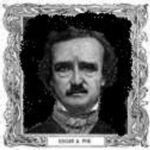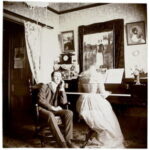There are stories that make a person’s hair stand on end and that make their blood run like a magenta, icy-cold river. What causes these feelings of terror? Edgar Allan Poe knows the answer to this question. Poe’s stories are credited to be some of the best Gothic fiction ever written. His work was considered unique for its time, and it still holds a certain uniqueness that has yet to be matched. His works have characteristics that are identifiable in every story, and they make known to the reader that “this is indeed the work of Edgar Allan Poe.” The settings always contain the common characteristics thought to belong in a true horror story. There are strange components present in every story. There are always horror-filled endings.
Is a person more likely to be scared in broad daylight with the birds chirping, or in the gloomy shadows of darkness with the silence screaming out loud? The answer is obvious. In Poe’s stories “The Tell-Tale Heart,” “Hop-Frog,” “The Cask of Amontillado,” and “Ligeia,” the setting is night time. Sunlight is thought to be representative of good, and darkness is thought to be representative of evil; therefore, the presence of darkness is certain to be in a Poe story. Take into account the location in a story. Nothing makes for a better horror-scene that a damp, dark, ominous castle. One of the most important elements of a Poe story is the architecture. It is usually of a Gothic nature. A foreshadowing of evil immediately becomes evident when reading from a description of the narrator’s new home in Poe’s “Ligeia”: “I purchased an abbey…The gloomy and dreary grandeur of the building, the almost savage aspect of the domain…had much in unison with the feelings of utter abandonment which had driven me into that remote and unsocial region of the country.” There is a sense of dark seclusion that puts the reader in a feeling of ominous suspense. In “The Cask of Amontillado,” the main scenes take place in damp catacombs. Along with the time of night, such locations set the horrifying mood of Poe’s stories.
In Poe’s stories, there is always the eerie presence of strangeness. Poe uses the elements of oddities and strange occurrences to give his stories a unique feeling of “not-of-this-world.” In “Hop-Frog”, one of the central characters is a crippled dwarf. Strangeness is a factor associated with bringing feelings of discomfort and grotesque horror. In “The Tell-Tale Heart,” the narrator, speaking about an old man’s eye, relates that “whenever it fell upon me, my blood ran cold; and so by degrees-very gradually-I made up my mind to take the life of the old man, and thus rid myself of the eye forever.” , revealing what can only be madness. A man decides to kill another man on the basis of an eye? Poe uses the element of madness, of what is under the shadow of “the unknown,” to bring a strange mystery into his plots.
The greatest element in all of Poe’s stories, what could be called his “signature”, is the certainty that there will always be a gruesome horror-filled ending. A terrifying occurrence will always happen. Although Poe’s stories are short stories, he always takes the time to let the reader get acquainted with the narrator, and then uses the reader’s trusting familiarity with the narrator to make the endings all the more scary and surprising. He shares the “madness” that the narrator feels, but still gives the conclusion such a twist that the reader can’t help but be shocked. In “The Cask of Amontillado,” the reader knows that the narrator harbors a hatred of the character Fortunato, but when the narrator bricks him into the wall of the catacombs, the reader still feels horror and shock from such a gruesome conclusion. In “Hop-Frog,” the reader knows that Hop-Frog is planning something, but when Hop-Frog sets the kings and his attendants aflame, the reader feels gruesome-filled surprise from the disgusting murder and from Hop-Frog’s obvious pride and lack of remorse in his words in the last scene: “I now see distinctly…They are a great king and his seven privy councilors…I am simply Hop-Frog, the jester-and this is my last jest.” How could he say such a thing when corpses are hanging from a chandelier? This is part of the mystery of Poe.
Poe’s works embodies Gothic fiction: They are dark, foreshadowing, and essentially evil. They contain the elements of horror, suspense, and surprise. His works have the stereotypical horror-story settings of nighttime, dark-imposing architecture, and desolate locations. There is always mystery and elements of madness and the unknown. A terrifying occurrence will always happen and death is always involved. It would not be a Poe story otherwise.




